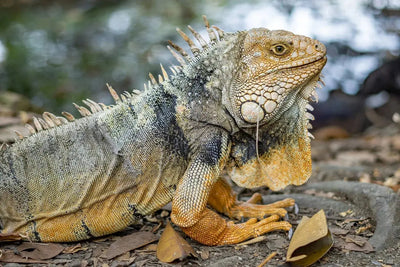The Importance of UVB Lights for Reptiles

Reptiles are fascinating creatures that require specific care to thrive in captivity. One crucial aspect of their well-being is providing them with the right lighting conditions, particularly UVB lights.
UVB lights emit ultraviolet B radiation, which is essential for reptiles to synthesize vitamin D3 and maintain proper calcium metabolism. Without adequate UVB exposure, reptiles can develop serious health issues, such as metabolic bone disease.
Choosing the right UVB light for your reptile is crucial to their overall health and well-being. In the next section, we will provide you with a comprehensive guide to selecting the best UVB lights for your scaly companions.
How to Choose the Best UVB Lights for Your Reptile
When selecting UVB lights for your reptile, there are several factors to consider:
- Reptile Species: Different reptile species have varying UVB requirements. Research the specific needs of your reptile to ensure you provide the appropriate UVB lighting.
- UVB Output: The UVB output of a light bulb determines the amount of UVB radiation it emits. Check the product specifications to ensure it meets your reptile's requirements.
- Lighting Distance: The distance between the UVB light and your reptile is crucial. Follow the manufacturer's guidelines to determine the optimal distance for your specific light bulb.
- Lighting Schedule: Reptiles require a consistent lighting schedule to mimic their natural environment. Ensure you provide the appropriate photoperiod (light and dark cycles) for your reptile.
- Light Bulb Type: There are various types of UVB light bulbs available, including fluorescent tubes, compact fluorescent bulbs, and mercury vapor bulbs. Each type has its own advantages and disadvantages, so research which one is best suited for your reptile.
- Fixture Type: Consider the type of fixture needed to house the UVB light bulb. Some bulbs require specific fixtures, so make sure you have the appropriate setup.
- Bulb Lifespan: UVB light bulbs have a limited lifespan and will need to be replaced periodically. Check the estimated lifespan of the bulb and plan for replacements accordingly.
By considering these factors and doing thorough research, you can select the best UVB lights for your reptile and ensure their optimal health and well-being.
Understanding the Role of UVB Light for Reptiles
Reptiles have unique needs when it comes to their lighting requirements. One essential component is UVB light, which plays a crucial role in their overall health and well-being.
1 Why do reptiles need UVB light?
UVB light is necessary for reptiles as it helps them produce vitamin D3, which is essential for calcium absorption. Without proper levels of vitamin D3, reptiles can develop metabolic bone disease, a condition that affects their bone growth and overall health. UVB light also helps stimulate their appetite and reproductive behaviors.
2 The benefits of UVB light for reptile health
The benefits of UVB light for reptiles are numerous. It not only aids in vitamin D3 production but also promotes natural behaviors and overall well-being. Exposure to UVB light helps reptiles regulate their body temperature, improves their immune system, and enhances their coloration. It also plays a vital role in maintaining proper eye health and preventing eye-related issues such as cataracts.
Choosing the Right UVB Light for Your Reptile
When it comes to providing the best care for your reptile, choosing the right UVB light is crucial. UVB lights are essential for reptiles as they help them produce Vitamin D3, which is necessary for calcium absorption and overall health. In this section, we will discuss the factors to consider when selecting a UVB light, the different types available, and the common features to look for in a quality UVB light.
1 Factors to Consider When Selecting a UVB Light
Before purchasing a UVB light for your reptile, there are several important factors to consider:
- Reptile Species: Different reptile species have different UVB light requirements. Research the specific needs of your reptile to ensure you choose the right light.
- UVB Output: The UVB output of a light is measured in UVB Index (UVB-I). Check the UVB-I rating to ensure it meets the recommended levels for your reptile.
- Light Size: Consider the size of your reptile's enclosure and choose a UVB light that provides adequate coverage.
- Light Distance: The distance between the UVB light and your reptile is crucial. Follow the manufacturer's guidelines to determine the ideal distance for optimal UVB exposure.
- Light Lifespan: UVB lights have a limited lifespan. Consider the average lifespan of the light and plan for regular replacements.
2 Different Types of UVB Lights Available
There are several different types of UVB lights available for reptiles, including:
- Fluorescent Tubes: These are the most common and affordable UVB lights. They provide a wide coverage area and are suitable for most reptile species.
- Compact Fluorescent Lights (CFLs): CFLs are smaller and more energy-efficient than fluorescent tubes. They are ideal for smaller enclosures or reptiles that require lower UVB levels.
- Metal Halide Bulbs: Metal halide bulbs produce both UVB and heat, making them suitable for reptiles that require higher basking temperatures.
- Mercury Vapor Bulbs: These bulbs emit both UVB and UVA rays and are suitable for reptiles that require high UVB and UVA levels, such as desert-dwelling species.
3 Common Features to Look for in a Quality UVB Light
When selecting a UVB light, there are certain features that indicate its quality and effectiveness:
- Full-Spectrum UVB Output: Look for a UVB light that provides a full spectrum of UVB rays, as reptiles require a specific range of wavelengths for optimal health.
- High-Quality Reflectors: Good reflectors ensure that the UVB light is evenly distributed throughout the enclosure, maximizing exposure.
- Easy Installation: Choose a UVB light that is easy to install and fits securely in your reptile's enclosure.
- Longevity: Opt for a UVB light with a long lifespan to minimize the frequency of replacements.
- Brand Reputation: Research reputable brands known for producing reliable and high-quality UVB lights for reptiles.
Setting Up the UVB Light in Your Reptile's Habitat
Proper lighting is crucial for the health and well-being of your reptile. In this section, we will guide you through the steps to set up the UVB light in your reptile's habitat.
1 Placement and Positioning of the UVB Light
- Place the UVB light on top of the habitat, preferably within a reptile lamp fixture. This will allow the UVB rays to penetrate through the mesh or glass top of the habitat.
- Position the UVB light at the correct distance from your reptile. Refer to the manufacturer's instructions or consult with a reptile veterinarian to determine the appropriate distance.
2 Recommended Distance and Duration of Exposure
- Most reptiles require UVB exposure for 10-12 hours a day.
- The recommended distance between the UVB light and your reptile is 12-18 inches.
3 Creating a Proper Basking Area
- Provide a proper basking area equipped with a heat lamp or heating pad.
- Locate the basking area directly under the UVB light.
- Ensure the basking area is large enough for your reptile to comfortably rest and soak up the heat.
Remember to regularly monitor the temperature and UVB levels in your reptile's habitat to ensure they are within the appropriate range. This will help maintain the overall health and well-being of your reptile.
In the next section, we will discuss the importance of providing a proper diet for your reptile to ensure their nutritional needs are met.
Monitoring and Maintaining UVB Light Performance
1 Regular checking of UVB light output
Regularly monitoring the UVB light output is crucial to ensure that your pet is receiving the necessary amount of UVB radiation. UVB bulbs tend to lose their potency over time, so it's important to check their output regularly.
To monitor the UVB light output, you can use a UVB meter. This device measures the intensity of the UVB radiation emitted by the bulb. Follow the manufacturer's instructions to use the UVB meter correctly.
Ideally, the UVB output should be within the recommended range for your specific pet's needs. If the output falls below the desired range, it may be time to replace the UVB bulb.
2 Replacing UVB bulbs
Over time, UVB bulbs lose their effectiveness and may no longer provide the necessary amount of UVB radiation. It's important to replace the UVB bulbs regularly to ensure your pet's health and well-being.
The frequency of UVB bulb replacement depends on the specific brand and type of bulb you are using. Some bulbs may need to be replaced every 6-12 months, while others may last up to 18 months. Refer to the manufacturer's instructions for the recommended replacement schedule.
When replacing the UVB bulb, make sure to turn off the UVB light fixture and allow it to cool down before handling the bulb. Follow the manufacturer's instructions for removing the old bulb and installing the new one.
3 Cleaning and maintaining the UVB light fixture
Cleaning and maintaining the UVB light fixture is essential to ensure its optimal performance. Over time, dust and debris can accumulate on the fixture, reducing the amount of UVB radiation that reaches your pet.
To clean the UVB light fixture, first, unplug it from the power source. Use a soft, damp cloth to wipe away any dust or dirt from the surface of the fixture. Avoid using harsh chemicals or abrasive materials, as they can damage the fixture.
Additionally, check the fixture for any signs of damage or wear. If you notice any cracks, exposed wires, or other issues, it's important to replace the fixture immediately. Damaged fixtures can pose a safety hazard to your pet and may not provide the necessary UVB radiation.
Regularly maintaining the UVB light fixture will help ensure its longevity and effectiveness. Follow the manufacturer's instructions for any specific maintenance recommendations.
Monitoring and maintaining the UVB light performance is crucial for the health and well-being of your pet. Regularly check the UVB light output, replace the bulbs as needed, and clean and maintain the fixture to ensure that your pet receives the necessary UVB radiation. By taking these steps, you can help provide a safe and healthy environment for your pet.
5 Common Mistakes to Avoid with UVB Lights
Proper setup and maintenance of UVB lights are crucial for the health and well-being of your pet. However, there are common mistakes that pet owners often make when it comes to UVB light care. Avoiding these mistakes will ensure that your pet receives the necessary UVB exposure for optimal health.
1 Incorrect UVB Light Setup
One common mistake is setting up the UVB light incorrectly. It's important to position the light within the recommended distance from your pet's habitat. The distance will vary depending on the specific species and the UVB bulb being used. Refer to the manufacturer's guidelines or consult a reptile specialist to determine the appropriate distance for your pet.
2 Using Expired or Low-Quality UVB Bulbs
Using expired or low-quality UVB bulbs is another mistake to avoid. UVB bulbs have a limited lifespan, and their effectiveness diminishes over time. It's important to regularly check the expiration date of your UVB bulbs and replace them when necessary. Additionally, investing in high-quality UVB bulbs from reputable brands will ensure that your pet receives adequate UVB radiation.
3 Neglecting Proper Maintenance
Neglecting proper maintenance of UVB lights can also lead to problems. Dust and other debris can accumulate on the surface of the bulb, reducing its effectiveness. It's important to regularly clean the bulb and remove any buildup. Additionally, make sure to check the wiring and connections to ensure they are secure and free from damage.
By avoiding these common mistakes, you can provide your pet with the optimal UVB exposure they need for their overall health and well-being. Proper setup, using high-quality bulbs, and regular maintenance will ensure that your pet receives the full benefits of UVB light.
Boost Your Reptile's Health with the Right UVB Lights
To ensure the best health for your reptile, it is crucial to choose the right UVB lights. Luckily, there is a webpage that offers a comprehensive range of reptile products and accessories: https://talis-us.com/fr/products/komodo .
A Diverse Selection of Reptile Products and Accessories
At https://talis-us.com/fr/products/komodo , reptile owners and enthusiasts can find a wide range of reptile ornaments, terrarium backgrounds, plants, rocks, and other decorative items. The webpage also provides reptile housing accessories such as terrarium substrate, habitats, cages, and stands.
Wide Range of Reptile Products
One of the unique selling points of this webpage is the variety of reptile products available. Whether you need dry, freeze-dried, frozen, gel, or live food options for your reptile, you can find them here. Additionally, the webpage offers reptile care and health products like thermostats, thermometers, water supplies, lights, hoods, fixtures, and heat sources.
Enhance Your Reptile's Habitat with High-Quality Products
By choosing products from https://talis-us.com/fr/products/komodo , you can ensure that your reptile's habitat is visually appealing and meets their specific needs. The high-quality products available on the webpage will contribute to the overall well-being of your reptile, promoting their physical and mental health.
Don't Miss Out on the Opportunity!
Enhance your reptile's habitat and provide them with the best care possible. Visit https://talis-us.com/fr/products/komodo to explore their extensive range of reptile products and accessories. Your reptile will thank you for it!
Note: This conclusion includes a call-to-action (CTA) to visit the webpage https://talis-us.com/fr/products/komodo for more information and to make a purchase.






